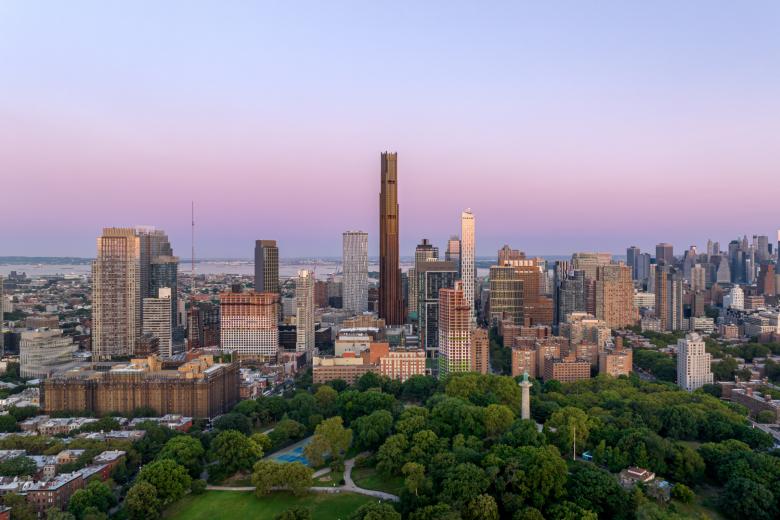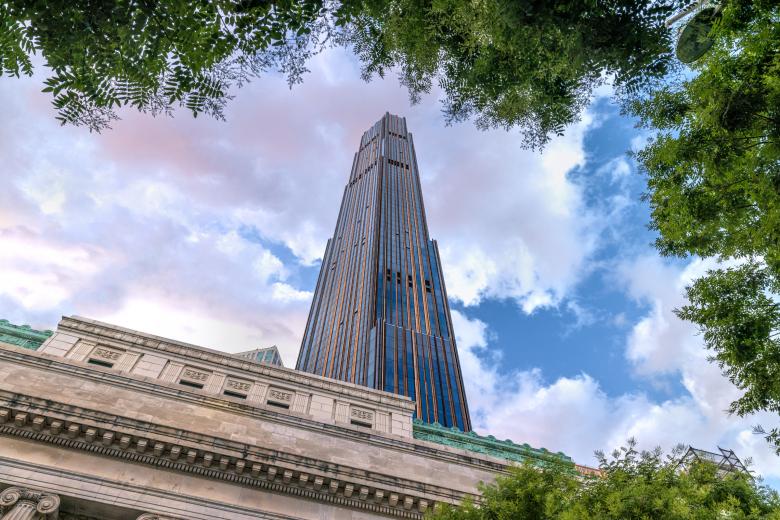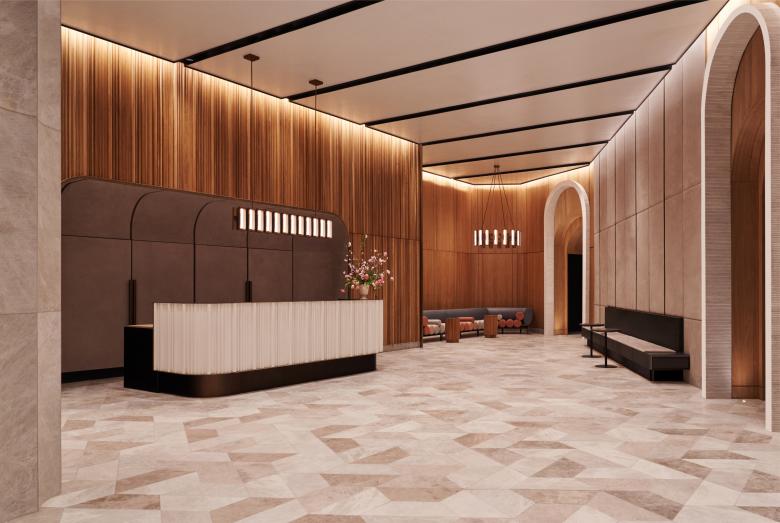5. September 2023
Photo: Max Touhey
Of the ten tallest buildings in New York City only one of them is outside of Manhattan: Brooklyn Tower, designed by SHoP Architects for JDS Development. The tower recently reached a milestone, and World-Architects got a peek inside.
Last month I was invited to be part of a small group getting a tour of Brooklyn Tower from SHoP Architects and Woods Bagot. The primarily residential tower — Brooklyn’s first and so far only supertall — had recently seen its exterior facade completed, and its first residents were moving in. But where to meet for the tour? Occupying most of a triangular site in Downtown Brooklyn, the tower’s address is technically on Flatbush Avenue Extension, a wide thoroughfare that extends from the Manhattan Bridge down toward Pacific Park Brooklyn, the development that was born Atlantic Yards and is anchored by SHoP’s Corten-clad Barclays Center. The two narrow streets heading away from Flatbush were both closed off, as construction continued on the podium and parts of the tower behind its completed glass and metal facades. That left the former Dime Savings Bank, the marble-clad early-20th-century landmark at the southwestern tip of the block, a building that has sat empty since 2014 but now provides substantial air rights for the 1,066-foot (325-m) tall tower.
Looking at Brooklyn Tower from Brownstone Brooklyn (Photo: Max Touhey)
Glancing around the domed interior of the old bank while waiting for SHoP founding partner Gregg Pasquarelli and Krista Ninivaggi from Woods Bagot, it was hard not to think about the future of the impressive space. Would it become a Trader Joe’s or some other larger retailer with a fondness for grand old buildings? Would it become an event space run by the likes of Cipriani, which already has venues in other NYC landmarks? Most importantly, would it be publicly accessible, as it was for more than a century, or just be used exclusively by tenants of Brooklyn Tower? (The latter is legally feasible, given that the tower’s developer, JDS Development, has owned the building since 2015.)
The answer would come later in the tour, but meeting inside Dime Savings Bank allowed Pasquarelli to explain how SHoP shaped a tower on an unconventional triangular site, finding inspiration inside an old building that is basically a small triangle on a larger triangular block. The solution was in the paving’s and matching coffered ceiling’s hexagons and triangles. “What if the tower became,” Pasquarelli recalled, “a series of interlocking hexagons?” A series of setbacks, he continued, “would spiral up to give a verticality and texture to the building” appropriate for “the crescendo of the Downtown Brooklyn skyline.”
Looking up at Brooklyn Tower from Dime Savings Bank (Photo: Max Touhey)
In actuality, when the Dime Savings Bank and Junior’s Restaurant, a holdout at the southeast corner of the site, are subtracted from the larger site, the footprint for the 93-story Brooklyn Tower is a trapezoid, not a triangle. Therefore, Pasquarelli and his team at SHoP easily could have given the tower a rectangular footprint, resulting in interiors and unit plans that are more conventional and easier to lay out versus a hexagonal footprint. But the hexagonal geometry carries with it a couple of benefits, one exterior and one interior: On the outside, the tower is always seen with at least two faces, as opposed to one or two faces with rectangular slabs or square point towers. So if the tower is seen while looking up Flatbush, or from a cross street, or even from Manhattan, it always has a similar appearance befitting its tallest-in-Brooklyn stature. (The zoning of the lot, Pasquarelli explained, means the tower will remain the tallest building in Downtown Brooklyn.) On the inside, as our group saw firsthand while walking through some model units on the 56th floor, the hexagonal plan resulted in living rooms with 130-degree corners rather than right angles. Even with columns anchoring the corners and interrupting the views, the panoramic sweep was a tangible benefit.
Inside one of the model units (Photo: Kelly Marshall)
Brooklyn Tower has a total of 550 residences split between rentals (studios to two-bedrooms) and condos (studios to four-bedrooms). Fittingly, the rentals occupy the lower floors of the tower, while the condos sit above them, starting at 535 feet (163 m) above the sidewalk. All of the units were designed by Gachot Studios, while the lobby and public spaces in the podium were designed by Ninivaggi from Woods Bagot. A highlight of the latter’s contributions is the lobby, a collaboration with Pasquarelli, where fluted columns, concave light fixtures, and fake dimes set into the coved ceiling by the elevators echo the tower’s 115-year-old neighbor. Even the custom couch designed by Ninivaggi features bolsters that could be likened to rolls of quarters or dimes. Not yet completed are the public areas and residential amenities in the podium, which will include a Life Time “luxurious athletic country club” and rooftop lap pools circling the Dime Savings Bank dome. Although the pools are a restricted amenity, Pasquarelli told me the space below the dome, while still to be determined, will definitely be publicly accessible. Good news: the “right” answer to my earlier queries.
Brooklyn Tower lobby (Photo: Adrian Gaut)
Before SHoP and JDS tackled Brooklyn Tower, the architect and developer collaborated on American Copper Buildings, two kinked towers near the East River linked by a skybridge with a swimming pool, and 111 West 57th Street, the skinniest of the five supertalls along Billionaires’ Row south of Central Park. The trio of JDS/SHoP projects are widely divergent in terms of massing, but they all share a departure from the all-glass norm that NYC and other cities are littered with from this century. The ACB pair aptly alternates windows with copper panels, while the all-glass north and south facades of 111 West 57th are bookended by custom terracotta panels. The “verticality and texture” of Brooklyn Tower are aided by stripes of blackened stainless steel, bronze, and copper in fluted, rounded, and triangular shapes.
Brooklyn Tower lobby (Photo: Adrian Gaut)
Brooklyn Tower’s metal and dark-glass facades, combined with the series of setbacks and crenelated spire, give the tower an appearance that could be described as Contemporary Gothic but which has drawn far too many “Eye of Sauron” comparisons. Eric P. Nash, in his new book Sky-High: A Critique of NYC’s Supertall Towers from Top to Bottom, is also less than kind to Brooklyn Tower, asserting that “the building could be plunked down in any sun-bleached American city from Atlanta to Dallas.” This writer is more positive, acknowledging the hold the Dime Savings Bank had on the architects but also seeing a debt to Ludwig Mies van der Rohe’s Seagram Building in the tower’s dark metal exterior, and echoes of the city’s early-20th-century skyscrapers in the tower’s asymmetrical setbacks. It is a brooding building that is hard to miss, sure, but it is very much of its place and considerably better than the spate of residential towers that have reshaped the NYC skyline this century.





